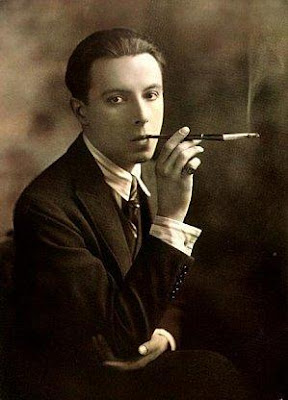
Most of you know I have an obsession with historical fashion.
Like, I would give my left arm (or saw off somebody else's) to go back in time and rock 1950s Dior gowns, or prance around in delicious cake-inspired Marie Antoinette creations.
I'm also obsessed with anything 1920s.
When you put both of my passions together, you get Erté.

Sit down, my little pupils, and let me tell you the story of one of the most famous pioneers in fashion history.
No other fashion designer, including Chanel or Dior, had greater influence in the 20th century than Erté. His flamboyant designs defined one of the most opulent and iconic decades in history: the 1920s. Traces of his style would later go on to mold fashion in the 1960s.

Erté was born as Romain de Tirtoff in 1892 to a wealthy family in St. Petersburg, Russia. When he was five, he stunned his parents by creating his first beautiful fashion design. It was a passion that took over his life. His father expected him follow in the family footsteps and become a naval officer, but Romain had other plans.

At 18, he changed his name to Erté (to avoid disgracing the family name) and became the apprentice for famed designer Paul Poiret in Paris. In 1915, he scored an enviable contract with Harper's Bazaar to design more than 200 covers.

In the 1920s, Erté introduced the world to "art-deco," a style illustrating the elegance, sophistication, and playfulness of the jazz age.

His fashion designs were in high demand from the biggest Broadway stars and Hollywood movie stars of the decade. He pieced together glitzy, sexy little showgirl costumes for the Ziegfeld Follies. He spent hours inspecting every detail of the glamorous, extravagant gowns created for films.

Erté's designs were deliciously exotic and outrageously impractical, which delighted both the working-class girls who worshipped his dresses from afar and the lavishly wealthy women who could afford to make him rich.

His gowns were painstakingly hand-made with beads, fur trim, lace, sheer draperies, leather, and glittering embroidery.

By World War II, however, the lust for his extravagance diminished, as society grew more practical. But his career revived in the 1960s.

Erté's designs can be found at the most famous art museums in the world.

The famous fashion designer died in 1990, at the age of 97.

Today, everyone from Anna Wintour to Karl Lagerfeld hails Erté as one of the most important figures in fashion history.
What do you think of his designs?
No comments:
Post a Comment